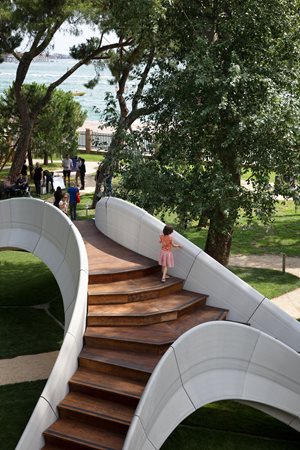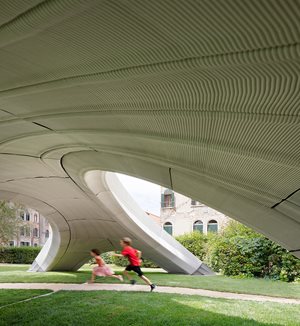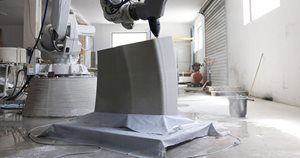Striatus
ZHA and EHA revisit a Roman construction technique with the latest 3D-printing technologies – using less material to do much more
 As any arch-building Roman could tell you, compression in structural design can support the same loads with much less material than deploying the brute strength of a horizontal beam
As any arch-building Roman could tell you, compression in structural design can support the same loads with much less material than deploying the brute strength of a horizontal beam
This is the principle at work in Striatus, an arched footbridge composed of 53 printed concrete blocks and assembled without mortar or reinforcement. Combining traditional techniques with advanced computational design and robotic manufacturing, the 16m x 12m footbridge is a joint development by the Block Research Group (BRG) at ETH Zurich and Zaha Hadid Architects Computation and Design Group (ZHACODE).
“Before strong, long-span beams were available, people used to make use of compression in structures a lot more,” says Shajay Bhooshan, co-founder of ZHACODE. “Roman arches are well known, but the Mexicans and Nubians also used compression very skilfully in creating vaulted ceilings. Compression makes very efficient use of materials – and less material usually means a lower carbon footprint and a better overall environmental performance.”
The bridge is made from printed concrete blocks that are partially hollow and weigh between 200 and 700kg. They were assembled on a temporary sculpted board support structure, and arranged in such a way that they are pushed towards each other by their own weight. With the temporary support removed, the structure uses only compression to hold itself together without the need for mortar or steel connections.
 The principles of compression have also been put to work in the blocks themselves to maximise the effectiveness of the 3D-printed concrete manufacturing process. Each was formed by up to 500 layers of printed concrete using a two-part mix in which a bead of concrete “ink” is printed together with an accelerator that causes it to set almost immediately.
The principles of compression have also been put to work in the blocks themselves to maximise the effectiveness of the 3D-printed concrete manufacturing process. Each was formed by up to 500 layers of printed concrete using a two-part mix in which a bead of concrete “ink” is printed together with an accelerator that causes it to set almost immediately.
“The accelerator is important because, unlike most concrete printing, the beads vary in thickness, and are not all laid down horizontally,” explains Bhooshan. “They are at varying angles so, without the accelerator, the sloping nature of the layers would cause the concrete to slip.” The unusual expedient of printing sloping layers allows them to be aligned at right angles to the expected flow of forces through the bridge: “The result is that the printed concrete is more stable because the layers are compressed together. That means shearing is avoided, and the blocks can be lighter because, like the bridge itself, they too benefit from the strength of compression.”
 The Striatus project stemmed from the PhD that Bhooshan is undertaking with the BRG at ETH Zurich. “I am looking at how you can design effectively with 3D printing in concrete. BRG had worked with Zaha Hadid Architects before, then more PhD students became involved, along with 3D-printing firm incremental3D, and concrete supplier Holcim. So it has been a real team effort.” Striatus is much more than an academic exercise, he stresses:
The Striatus project stemmed from the PhD that Bhooshan is undertaking with the BRG at ETH Zurich. “I am looking at how you can design effectively with 3D printing in concrete. BRG had worked with Zaha Hadid Architects before, then more PhD students became involved, along with 3D-printing firm incremental3D, and concrete supplier Holcim. So it has been a real team effort.” Striatus is much more than an academic exercise, he stresses:
“We see real environmental benefits from this approach. As well as minimising material, our blocks are free from steel reinforcement and connections – the mix does not include fibre reinforcement either. So as well as using less steel, it would be easy to take apart and reassemble at a new location. Alternatively, it would be straightforward to recycle the concrete itself as there is no need to remove any steel first.” The bridge is currently exhibited at the Giardini della Marinaressa park for the Venice Architecture Biennale.
Interview by Tony Whitehead
Published in CQ Autumn 2021